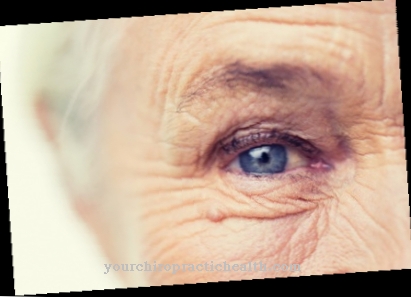Under the term Angiogenesis all metabolic processes that involve the growth or new formation of blood vessels are summarized. Angiogenesis is a complex process in which endothelial progenitor cells, smooth muscle cells and pericytes play a role. A promotion or inhibition of angiogenesis is increasingly used for therapeutic purposes - especially in tumor therapy.
What is Angiogenesis?

Angiogenesis in the narrower sense only regards the formation of new blood vessels as an expansion of the existing vascular system, while the formation of blood vessels from precursor cells, such as during embryonic development, is also referred to as vasculogenesis. In many cases, however, all processes that lead to the formation of new blood and lymph vessels are summarized under the term angiogenesis.
During embryonic development, omnipotent angioblasts form from the mesoderm in the early stages, which can further develop into vascular endothelial cells for angiogenesis. Some of the angioblasts remain in the blood for life as undifferentiated hemangioblasts with stem cell potential.
After the embryonic and growth phase, angiogenesis serves, if necessary, to expand the blood and lymphatic system and, above all, to supply new tissue during wound healing. The body is even able to use angiogenesis to create replacement vessels for blocked or interrupted veins.
The formation of new vessels is mainly controlled by growth-promoting signal hormones such as VEGF (vascular endothelial growth factor) and bFGF (basic fibroblast growth factor). The endothelial proliferation and migration required in angiogenesis requires the stimulation of the signal hormone bFGF to trigger and control the process.
Function & task
Almost all tissue is connected to the body's supply and disposal system. With a few exceptions, the exchange of substances takes place in the capillaries of the bloodstream. In the capillaries that surround the alveoli in the pulmonary circulation (also known as the small circulation), the blood absorbs molecular oxygen through diffusion processes and releases carbon dioxide.
The opposite exchange of substances takes place in the capillaries of the body's circulation. The blood releases oxygen and other required substances to the tissue and absorbs carbon dioxide and other metabolic products. The blood circulation enables certain metabolic processes in the body to take place centrally in specialized organs and the metabolic products in the blood can be transported as far as desired.
During embryonic development and during the human growth phase, angiogenesis creates the conditions for the exchange of substances in the capillaries and the transport of substances within the body through the formation of a network of arteries, arterioles, capillaries, venules, veins and lymph vessels. The main task of angiogenesis is therefore to provide for the creation and growth of the required network of many different types of blood and lymph vessels.
After the growth phase is complete, angiogenesis is primarily useful as a repair mechanism for injured tissue. Broken veins have to be bridged or a new network has to restore blood circulation.
Angiogenesis also plays an important role in the remodeling or rebuilding of tissues in the body during the adult phase. Local angiogenesis is stimulated by various messenger substances such as VEGF and bFGF, which can dock on special receptors in the blood vessels.
In addition, fibroblast growth factors (FGF) play a role. A total of 23 different FGFs are known, each of which is systematized with an ordinal number from 1 to 23. They are single-chain polypeptides, i.e. chain molecules that consist of amino acids strung together. FGF-1 in particular, which consists of a chain of 141 amino acids and can therefore also be called a protein, has an important function in angiogenesis. It can dock on all FGF receptors and has a particularly activating effect on the proliferation and migration of endothelial cells.
Illnesses & ailments
Diseases and complaints are linked to both reduced angiogenesis and undesired angiogenesis. For example, it is it that enables different types of tumors and theirs to grow Metastasis.
In the case of pathological changes in the blood vessel system in local tissue, such as coronary heart disease (CHD) and peripheral occlusive disease (PAD), e.g. a smoker's leg, increased angiogenesis could lead to a replacement network of veins and at least partially restore the original function.
Since the late 1990s, the fibroblast growth factor FGF-1, which is known to be highly effective, was used clinically for the first time. In addition to angiogenesis, FGFs are also of particular importance in the regeneration of nerve and cartilage tissue.
The growth of certain tumors is determined by the efficiency of angiogenesis. Tumors are usually very energy-hungry and require a good network of specially created capillaries to supply and remove their cells. In tumors that are prone to metastasis, the metastatic cells are distributed in the body via the blood.
Since messenger substances such as FGFs, VEGF and bFGF play a decisive role in angiogenesis, the therapy aims to inhibit the messenger substances in order to stop the angiogenesis in connection with the tumor tissue. At best, the tumor tissue would starve and die. A first drug aimed at inhibiting the messenger substance VEGF was approved in Germany in 2005 and is mainly used in advanced colorectal cancer.
In age-related macular degeneration (AMD), too, in which the increased formation of new vessels with insufficient stability leads to the gradual destruction of the visual cells, attempts are made to inhibit the undesired process of angiogenesis on the retina with an anti-angiogenesis drug Stop the breakdown of photoreceptor cells in the macular area.













.jpg)

.jpg)
.jpg)











.jpg)